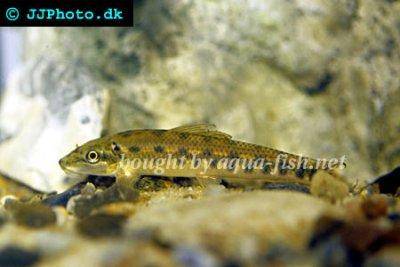Chinese algae eater - Gyrinocheilus aymonieri
Scientific name: Gyrinocheilus aymonieri
Common name: Chinese algae eater
Family: Gyrinocheilidae
Usual size in fish tanks: 20 - 28 cm (7.87 - 11.02 inch)
014
Recommended pH range: 6 - 8
Recommended water hardness: 4 - 18°N (71.43 - 321.43ppm)
0°C 32°F30°C 86°F
Recommended temperature range: 22 - 28 °C (71.6 - 82.4°F)
The way how these fish reproduce: Spawning
Where the species comes from: East Asia
Temperament to its own species: aggressive/territorial
Temperament toward other fish species: aggressive to smaller
Usual place in the tank: Bottom levels
General Information
Chinese Algae Eaters are commonly purchased as juveniles to help control algae in aquariums. While they are effective cleaners when young, they become more territorial and aggressive as they mature. For this reason, it's advisable to keep them in a species-only tank in the long term to avoid injury or stress to other tank mates. In a community tank, they may start to exhibit aggressive behavior, especially towards slow-moving or flat-bodied fish.
When first introduced to the aquarium, they might be skittish and prefer to hide. This is a normal behavior as they acclimate to their new environment. Adding plenty of plants, rocks, and other hiding spots can make them feel more secure, gradually encouraging them to become more active and confident over time.
Feeding
As juveniles, Chinese Algae Eaters are primarily herbivores, feeding on algae and plant matter. However, their dietary needs change as they grow, and they will require a mix of plant and animal-based foods. To ensure a balanced diet, provide algae wafers or fresh vegetables like peas, zucchini, and spinach. As they mature, supplement their diet with protein-rich foods such as bloodworms, daphnia, and other live or frozen foods. They will also readily accept spirulina flakes, which are beneficial for their health and coloration.
Sexing
Sexing Chinese Algae Eaters can be challenging. Generally, females tend to have a rounder, fuller body shape compared to males, especially when they are ready to spawn. However, this is not a definitive method, as some males may also appear plump. Observing behavior and subtle physical differences over time can provide more clues, but distinguishing between sexes with certainty can be difficult.
Breeding
Breeding Chinese Algae Eaters in a home aquarium is a rare and challenging feat. In the Far East, they are often bred successfully with the aid of hormone treatments, but such methods are typically not available to hobbyists. If you attempt to breed them naturally, you will need a lot of patience and some luck. Mimic their natural habitat by providing a well-planted tank with plenty of hiding spots. They are egg-layers, and the fry typically hatch within 2-3 days. Newly hatched fry will feed on algae and other small particles in the tank. However, even under ideal conditions, the survival rate of the fry can be quite low.
Lifespan
Chinese Algae Eaters have a typical lifespan of around 5 years, though with optimal care and a well-maintained environment, some individuals can live even longer.
Q&A
The following answers were moved here from aqua-fish.net/answers due to merging.
-
Where do Chinese algae eaters lay their eggs?
Answer: In captivity, successful breeding is extremely rare and mostly accidental, so it is not well-documented where they lay their eggs. Currently, most Chinese Algae Eaters are caught in the wild or bred in commercial farms with the help of hormone treatments.
-
What fish is commonly mistaken for the Siamese algae eater?
Answer: The Chinese Algae Eater is often mistaken for the Siamese Algae Eater due to their similar appearance and algae-eating behavior. However, Chinese Algae Eaters are generally more aggressive towards other fish. Another lookalike is the Flying Fox. The key difference is that the Flying Fox has a black stripe that stops just before the caudal fin, whereas the stripe on the Siamese Algae Eater runs through to the end of its tail fin.
Pictures
Bought by aqua-fish.net from jjphoto.dk. Two pictures were provided by pitugo.










